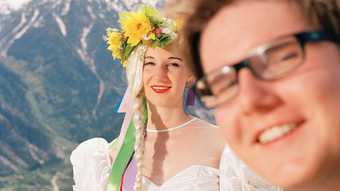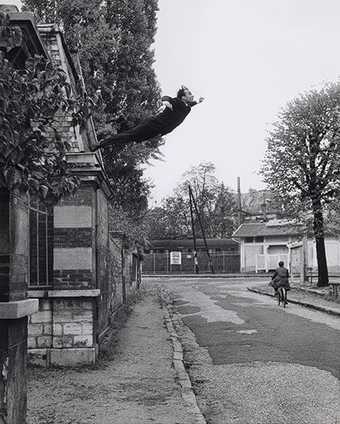
Yves Klein
Leap into the Void 1960
© Yves Klein, ADAGP, Paris
Photo: Shunk–Kender © Roy Lichtenstein Foundation
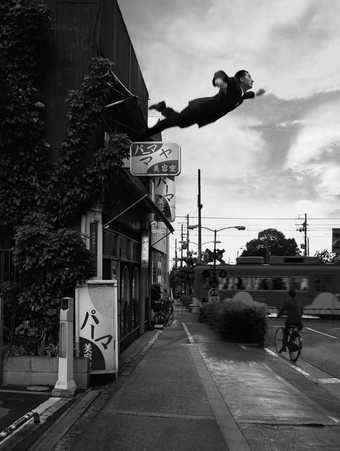
Yasumasa Morimura
A Requiem: Theater of Creativity/Self-Portrait as Yves Klein 2010
Gelatin silver print on paper, 1200 x 900mm
© Yasumasa Morimura, courtesy Galería Juana de Aizpuru, Madrid, and Yoshiko Isshiki Office, Tokyo
The most famous performance photograph of all time must be the one known as Saut dans le vide (Leap into the Void), showing the artist Yves Klein apparently jumping into space from a building on a quiet street. It is in fact a photo-montage, made for Klein from photographs taken in the Paris suburb of Fontenay-aux-Roses in 1960 by the photographic partners Harry Shunk and János Kender. Klein made the jump on to a tarpaulin held by a group of his judoka friends, who were later edited out. This was, Klein claimed, his second such jump, the first similarly from a two-storey building several months earlier. Whether you believe his claim or not, the result is still a great image – ecstatic, impossible, truly ‘spectacular’ – with which to advertise your new ideas about art. More than half a century later, it’s become one of the great art clichés, but like all good artworks still retains enough of its potency to introduce the new exhibition at Tate Modern, which explores the relationship between performance and the camera.
Klein published the photograph in Dimanche (Le journal d’un seul jour), his parody of a Sunday newspaper, where he expanded his idea of the ‘theatre of the void’, an imaginary space where art and life could be merged. Tate’s exhibition looks at some of the ways artists have used the camera across its history, as a means of recording, enabling, constructing, reflecting and framing their works – and at the same time underscoring what the artist Mel Bochner describes when writing about photography as ‘a distrust of [its] truth function’.
The word ‘selfie’ might have entered the language only in 2002, but the camera offered a licence to perform as soon as it was invented. It provided not only the means to record a performance, but also – pace Klein – to attempt the double trick of convincing the viewer that the resulting photograph was a record of an immutable truth.
What is probably the first performance photograph was taken in 1840, when Hippolyte Bayard posed, half-naked, for his daguerreotype Self-Portrait as a Drowned Man. It was a statement of protest and defeat. Bayard believed he had invented photography before Louis Daguerre and Henry Fox Talbot had registered their claims in 1839, but had been prevented from registering his. His consolation prize was to have made what is probably the first fictional photograph, since despite the fatalistic caption, ‘The corpse which you see here is that of M. Bayard, inventor of the process that has just been shown to you…’, he lived until 1887. In 1888 Kodak introduced the Box Brownie, an inexpensive portable camera which would go on to make performers of us all.
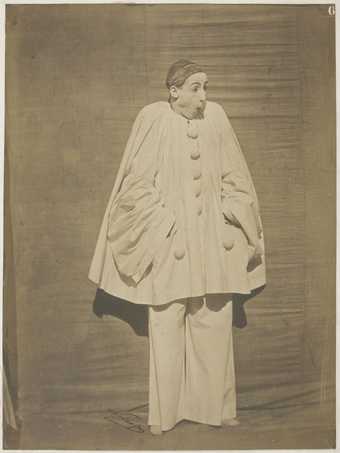
Gaspard-Félix Tournachon (Nadar)
Adrien Tournachon Pierrot surpris – Album des figures d’expression du mime Deburau, Pl.6
1854 Musée d’Orsay (Paris, France)
By this time performing for the camera had been co-opted for publicity purposes, not least by the theatre. La Tosca – the play by Victorien Sardou that Puccini later turned into an opera – had been written for Sarah Bernhardt, who first played the role in 1887. As she had done three years before as Lady Macbeth, she posed in costume for the great French portraitist Nadar, to produce what Simon Baker, Tate’s head of photography and curator of the show, describes as ‘an early production still’.
At the end of the 19th century the American Fred Holland Day took photographic fiction to its extreme, re-creating the life of Christ with himself in the title role. He starved, let his beard grow long and, when it came to the crucifixion scene, made a series of close-ups, The Seven Words 1898, based on Jesus’s last utterances on the cross. In one sense it’s a giant leap, but in another not so far, to the late 1970s and Cindy Sherman’s early Film Stills 1977–80, staged on the streets of downtown Manhattan. As the critic Douglas Crimp wrote in his 1980 essay The Photographic Activity of Postmodernism, Sherman’s photographs ‘use art not to reveal the artist’s true self, but to show the self as an imaginary construct’. Photography had acquired the power, particularly for women, to create an artificial image and market its stereotyping potential. Sherman’s photographs were both a construct of and a commentary on the manipulative power of the image.

Cindy Sherman
Untitled Film Still #17 (1978, reprinted 1998)
Tate
Photography was adopted by artists particularly in that fertile period of the 1960s and early 1970s when the traditional genres of painting and sculpture were under attack. Art was splintering into new forms that included performance, dance, video, installation, happenings, body art, land art and photography, and artists needed a record. Pop had dispensed with the single image as artists reacted against the claims of uniqueness and value made by easel painting. Consumerism, advertising, celebrity and irony were the subjects to explore; appropriation and multiples the emerging forms. For post-minimal and conceptual artists interested in serial imagery, the document and the record, the camera was the perfect tool. The ‘unskilled’ photograph, as Lawrence Alloway called it in his introduction to his self-described ‘exhibition/ catalogue’ Artists and Photographs 1970, only underscored the belief that the idea was more important than the image. At the same time art was becoming political, exploring identity, gender, media manipulation and issues of social and economic class. For artists, the camera came into its own as an instrument that could document and make widely available pictures of events and artworks that were never intended to hang on a museum wall.
This shift had been predicted by Allan Kaprow – often credited as the instigator of the ‘happening’ (though Klein might take issue with that) – in his essay The Legacy of Jackson Pollock, published in 1958, two years after Pollock’s death. At this point, Kaprow wrote
Artists must become preoccupied with and even dazzled by the space and objects of our everyday life, either our bodies, clothes, rooms or, if need be, the vastness of Forty-second Street… we should utilise the specific substances of sound, movements, people, odours, touch. Objects of every sort are materials for the new art: paint, chairs, food, electric and neon lights, smoke, water, old socks, a dog, movies, a thousand other things that will be discovered by the present generation of artists… Young artists of today need no longer say, “I am a painter” or “a poet” or “a dancer”. They are simply artists. All of life will be open to them’
For those working in New York in the late 1960s, one of the crucial factors in their development was geographic. As the industrial areas of Lower Manhattan were listed for demolition, artists rented cheap loft space that doubled as studios to present their work. The derelict streets, river piers and rooftops became the spaces where art was acted out and photographed. This coincided exactly with the period in which Shunk-Kender were at their most active.
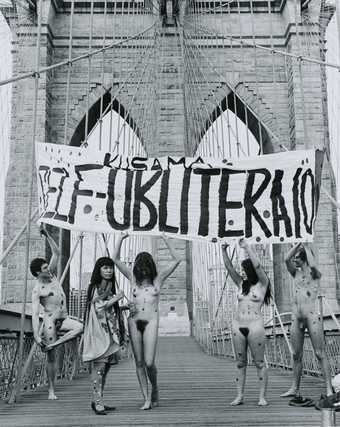
Yayoi Kusama
Anti-War naked happening, Brooklyn Bridge, New York, 1968, documented by Shunk- Kender
Gelatin silver print on paper, 254 x 203mm
© Yayoi Kusama, photo: Shunk-Kender (Harry Shunk and János Kender)
The Japanese artist Yayoi Kusama arrived in New York in 1958. She was 29. In a decade she moved from painting to installation work to staging downtown happenings. In 1968 her Anatomic Explosion, with its naked performers, took place on Wall Street and outside the UN building, while other anti-war events were held on Brooklyn Bridge. The same year, her Naked Event – the bodies were painted with large coloured dots – was staged in an unidentified studio. Shunk-Kender were there to record them. In some cases they contributed more than just documentary images. In 1971 the videomaker and curator Willoughby Sharp invited a group of 27 artists to create works on Pier 18, one of the abandoned industrial piers on the Hudson, on the west side of Manhattan. For his piece Dan Graham, dressed in jeans and a singlet, strapped a camera to different areas of his body, giving the lens as much autonomy as possible: ‘Still camera pressed to body – beginning at my feet, each shot progressively spirals to top of my head – Lens faces out – back of camera slide pressed flush to contour of skin.’ As Graham worked Shunk-Kender made a parallel series of cityscapes in which Graham’s figure is seen from different vantage points, but always in the frame.
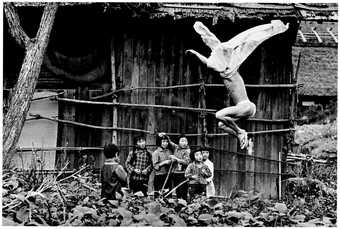
Eikoh Hosoe
Kamaitachi 1969
Private collection
© Eikoh Hosoe courtesy of the artist, Akio Nagasawa Gallery | Publishing (Tokyo) and Jean-Kenta Gauthier (Paris)
All 27 participants in the Pier 18 project were men. It was one of the ignition points for women artists: despite signal works being made by Kusama, Louise Bourgeois, Eleanor Antin and Joan Jonas, they were still in the minority. But over the next decade, gender politics, and women’s art in particular, would become an increasingly important factor (though arguably it has been only since the 1990s that the value of their works has been fully recognised). In 1970 Jonas made a long trip to Japan. On her return she added the influence of Noh and Kabuki theatre to her street performances. In 1972 her work Delay, Delay was performed on a derelict 10-block site in Lower Manhattan as spectators watched from the roof of 319 Greenwich Street. In 1973 Babette Mangolte, the cinematographer and filmmaker who had moved to New York from Paris in 1970 to escape the male-dominated French film industry, photographed Trisha Brown’s nowfamous Roof Piece, in which 14 dancers performed across the rooftops from 420 West Broadway to just above Wall Street and back again, signalling to one another.
While these new art forms were emerging across America and Europe, some of the most powerful works of performance and photography were being made in Japan, little over a decade after the devastation of the Second World War. In 1959 the photographer Eikoh Hosoe saw the dancer Tatsumi Hijikata perform his adaptation of Mishima’s novel Kinjiki (Forbidden Colours) 1951, and asked if he could photograph him. The culmination of their collaboration was Kamaitachi, a dramatic dance-narrative performed in the villages and open landscape of northern Japan from 1965 to 1969, where Hijikata had grown up and Hosoe had been evacuated during the war. According to Japanese legend, Kamaitachi is a demon that takes the form of a weasel, haunting the rice fields and slicing its victims with a sickle or a razor. In his 1989 essay about Hosoe, Mark Holborn quotes another popular definition which brings Kamaitachi much closer to an atomic blast: ‘A lacerated wound caused by a state of vacuum which is produced partially in the air, owing to a small whirlwind.’ The two artists had created what Holborn describes as ‘an autobiography of fear… the first breeze of a nuclear age’.

Ivars Gravlejs
Scream and Flash 1995, printed 2009
From a series of 15 black-and-white photographs on paper, 180 x 130mm
© Ivars Gravlejs
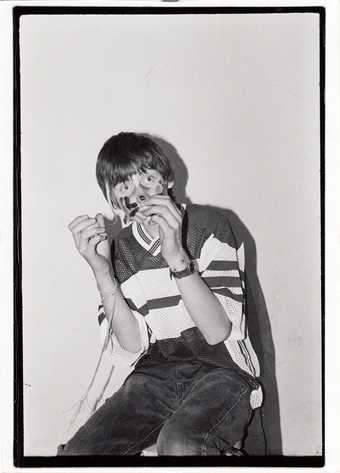
Ivars Gravlejs
Scream and Flash 1995, printed 2009
From a series of 15 black-and-white photographs on paper, 180 x 130mm
© Ivars Gravlejs
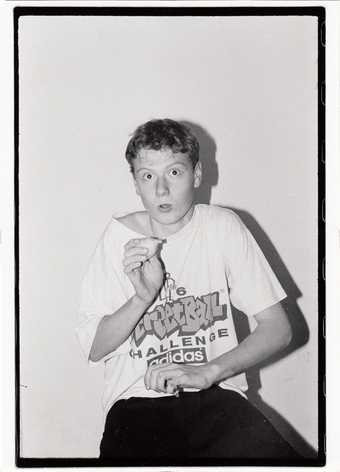
Ivars Gravlejs
Scream and Flash 1995, printed 2009
From a series of 15 black-and-white photographs on paper, 180 x 130mm
© Ivars Gravlejs

Ivars Gravlejs
Scream and Flash 1995, printed 2009
From a series of 15 black-and-white photographs on paper, 180 x 130mm
© Ivars Gravlejs
Many artists used the camera with themselves as a model or vehicle for their work. In 1977 two dissident Soviet artists, Vitaly Komar and Alexander Melamid, were given permission to travel to Israel, going on to New York in 1978. In the USSR they had created their own art movement, Sots Art, which they described as ‘a unique version of Soviet pop and conceptual art, which combines the principles of dadaism and socialist realism’. Many of their works were destroyed by the state. In 1976, after friends sent them catalogues from department stores in the West, they assembled A Catalogue of Superobjects: Supercomfort for Superpeople, a selection of household items which, like Duchampian readymades or surrealist impossible objects, they adapted and modelled on themselves and their friends. A metal oven shelf was curved into a visor; a wooden drawer had two large holes drilled into it so it could be slipped on like a sweater – it was classified under ‘Furniture to Wear’. If, they observed, the West suffered from an overproduction of consumer goods, in the Soviet Union ‘there is an overproduction only of ideology’. Once in New York, their works were exhibited and the catalogue published. They continued to work together for another 25 years, established a company, Komar & Melamid Inc, for the buying and selling of human souls (a successful ad campaign netted several hundred, including Andy Warhol’s) and even got their names in lights in Times Square.
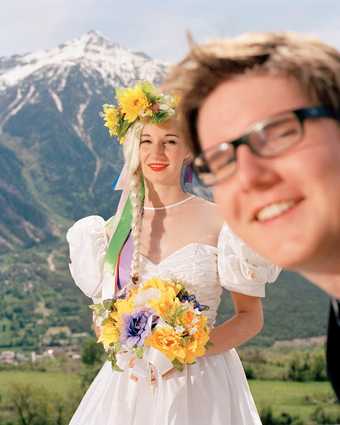
Romain Mader
Ekaterina: Mariage à Loèche-les-Bains (Marriage in Leukerbad) 2012
© Romain Mader / ECAL
Photography has extended an open invitation to artists to parody the tropes and clichés of publicity shots and propaganda. In 2010, in his series A Requiem: Theater of Creativity, the young Japanese artist Yasumasa Morimura pays homage to some of the greats of contemporary art. In Self-Portrait as Black Andy he dons the blank expression, leather jacket and silver wig. Self-Portrait as Jackson Pollock re-creates the famous session in which Hans Namuth photographed and filmed Pollock in action. In Self-Portrait as Yves Klein he re-creates, obviously, the Leap. But not all self-portraits require a costume drama. In 2011 the American photographer Lee Friedlander published a compendious book of selfportraits that took him from 1958 to 2011. What might have appeared to be an exercise in solipsism turned out to be very moving as time did its work.
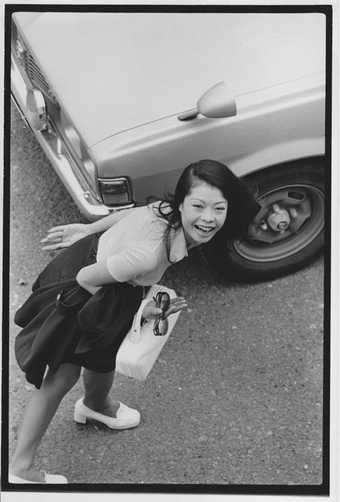
Masahisa Fukase
From Window 1974
© Masahisa Fukase Archives. Courtesy of Michael Hoppen Gallery.
The most poignant series in the Tate show, however, is not self-portraiture, at least not in the obvious sense. It is a sequence of black-and-white pictures taken by the great Japanese photographer Masahisa Fukase of his wife as she leaves for work each morning, looking back up at the window where she knows he’ll be waiting with his camera at the ready. What I think about when I see them is not so much the face of the person leaving, but the feelings of the person being left behind.

